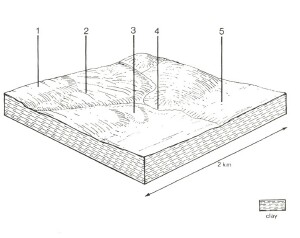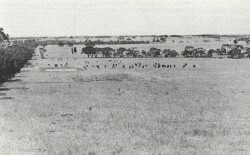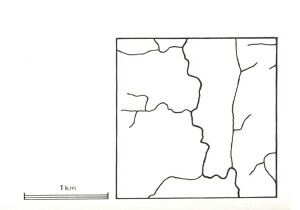Paraparap Land System
Download the pdf version of this document: Paraparap Land System (PDF - 461 )
To view the information, PDF requires the use of a PDF reader. This can be installed for free from the Adobe website (external link).
| Between the lateritic plateaux of the Gherang Gherang land system and the basaltic plains of the Freshwater Creek land system, a long narrow plain extends from the Barwon River near Winchelsea to the middle reaches of Thompson Creek. Deeply weathered duplex soils are found on most of this land system, with occasional areas of aeolian sand. Remnants of woodlands and open forests are found along many reserves with the unusual occurrence of Eucalyptus pauciflora on many of the better-drained and less fertile sites. Most areas have been cleared for agriculture and, despite the fairly low rainfall, dairy farming is common. Other uses include sheep and beef cattle grazing and cereal cropping. Soil salting is a problem in many areas and some minor gully erosion has also occurred. |  |
 Clearing has been widespread, but an abundance of vegetation in the road reserve adds an appealing dimension to the landscape. |  |
Area: 138 km2 | Component and its proportion of land system | ||||
1 35% | 2 30% | 3 10 | 4 15% | 5 10% | |
| CLIMATE Rainfall, mm | Annual: 600 – 650, lowest January (30), highest August (65) | ||||
| Temperature, 0oC | Annual: 13, lowest July (9), highest February (19) | ||||
Temperature: less than 10oC (av.) June – July | |||||
Precipitation: less than potential evapotranspiration October – mid April | |||||
| GEOLOGY Age, lithology | Plio-Pleistocene sediments consisting of clayey sand, sandy clay and lateritic detritus | ||||
Recent aeolian sand | |||||
| TOPOGRAPHY Landscape | Gently undulating plain lying between basalt to the north and lateritic plateaux to the south | ||||
| Elevation, m | 40 – 130 | ||||
| Local relief, m | 20 | ||||
| Drainage pattern | Dendritic | ||||
| Drainage density, km/km2 | 2.5 | ||||
| Land form | Gentle rise | Valley floor | |||
| Land form element | Crest, upper slope | Middle slope | Crest, slope | Lower slope | - |
| Slope (and range), % | 3 (0-11) | 4 (1-7) | 5 (2-10) | 4 (0-7) | 1 (0-2) |
| Slope shape | Convex | Linear | Irregular | Convex | Concave |
| NATIVE VEGETATION Structure | Open forest | Woodland | Low woodland | Woodland | Woodland |
| Dominant species | E. viminalis, E. ovata, E. pauciflora, Acacia melanoxylon | E. viminalis, E. ovata, Casuarina stricta, C. littoralis | E. viminalis, E. obliqua | E. ovata, E. viminalis, Casuarina stricta | E. camaldulensis, E. viminalis, Acacia melanoxylon |
| SOIL Parent material | Sandy clay | Sandy clay | Siliceous sand | Sandy clay | Sand, silt and clay |
| Description | Mottled yellow and red duplex soils | Yellow-brown sodic duplex soils, coarse structure | Grey sand soils, uniform texture | Yellow sodic duplex soils | Brown gradational soils |
| Surface texture | Sandy loam | Fine sandy loam | Loamy sand | Sandy loam | Fine sandy loam |
| Permeability | Moderate | Low | Very high | Moderate | High |
| Depth, m | >2 | >2 | >2 | >2 | >2 |
| LAND USE | Cleared areas: Dairy and beef cattle grazing on mainly improved pastures; cereal cropping; some sand extraction. | ||||
| SOIL DETERIORATION HAZARD Critical land features, processes, forms | Low inherent fertility, phosphorus fixation and leaching of permeable A horizons leads to nutrient decline. | Dispersible subsoils are prone to gully erosion and slumping of road batters. | Low inherent fertility and high permeability lead to nutrient decline. Weakly structured surfaces with low water-holding capacity are prone to wind erosion. | Sodic subsoils with high seasonal water tables are prone to soil salting. Dispersible subsoils are prone to gully erosion. | Seasonal saline water table development leads to soil salting. Rapid surface run-off from adjacent areas leads to scouring and gully erosion. Weakly structured surface soils in poorly drained areas are prone to compaction. |


